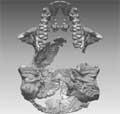A new episode of enlightened human evolution

The skeleton found 4.4 million years ago in an area of Ethiopia is called sheep. In a special issue of the journal Science has realized the research carried out on the basis of this individual of the species Ardipithecus ramidus and in other parallel findings.
It is not the oldest fossil proposed as a precursor of the human being, but the most complete. In fact, cranial, mandibular, pelvic, hand and foot bones of Ardi have been found, with a total of 125 fragments. All of them have allowed them to know the characteristics that characterized the living beings of the evolutionary branch that the human being gave at that time.
For they have seen that by then they were already able to walk on two legs, like humans. Unlike humans today, they could place the thick toe perpendicular to others. Thus, they could climb much more easily through the trees in search of food, sleep or escape from predators.
Until now, the Lucy skeleton was the oldest best preserved skeleton of human ancestors. Ardi has taken his place a million years before Lucy.
Image courtesy of: Digitized remains of various parts of Ardi's body. From top to bottom and from left to right, Ardi skull, pelvis, hand and foot (Science/AAAS).
Buletina
Bidali zure helbide elektronikoa eta jaso asteroko buletina zure sarrera-ontzian











